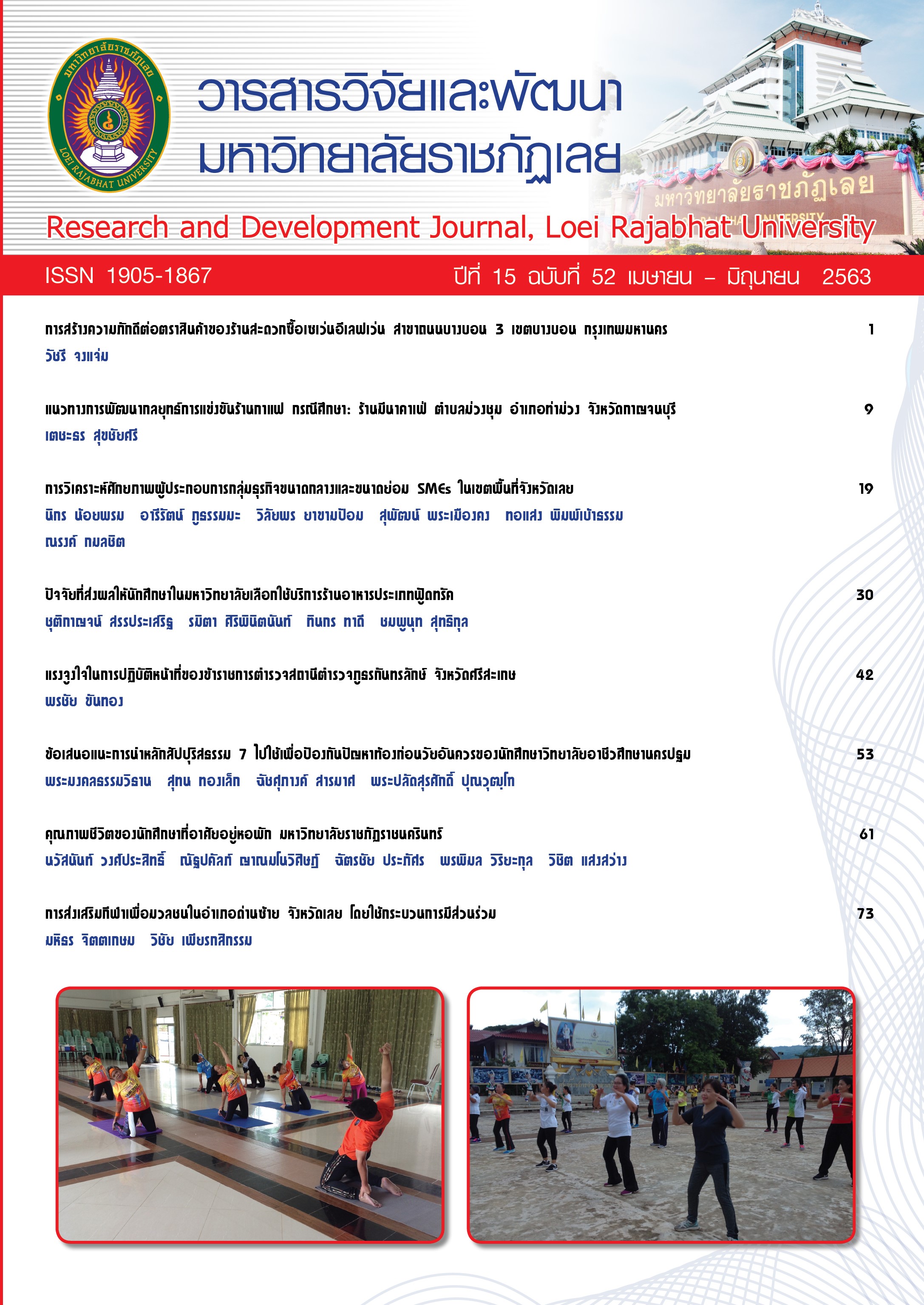The Quality of Life of Students Living in Dormitory Rajabhat Rajabhat University
Keywords:
the quality of life, students, dormitory, Rajabhat Rajanagarindra universityAbstract
The research was to compare in the quality of student’s lives in dormitory Rajabhat Rajabhat University classified by genders, ages, faculties, college years, grade averages, costs of living, incomes and expenses difference, roommate’s faculties, extra incomes and a number of room members. The population was the 1350 students in the academic year 2019 living in the university’s dormitory determined the sample size by using Krejcie & Morgan table as 316 students. Stratified random sampling was used in this research, collecting data by questionnaire that showed the value of reliability as 0.97. The sample sampling method was used in this research. The statistical methods for data analysis were average, percentage, standard deviation, and t-test, F-test.
This study found that the quality of student’s lives in the university’s dormitory was moderate as a whole. The researcher analyzing for each factor found that the highest average factor was education. Next below average factors were society, health, environment, and serviced facility around the dormitory. The lowest average factor was the quality of the room. The average score of comparison result showed that these factors; genders, faculties, college years, incomes, extra incomes, a number of room members were different caused the quality of student’s lives was quite different, but on other hand, the factors of ages, grade averages, incomes and expenses difference, and roommate’s faculties were different caused the quality of student’s lives was not different and statistically significant at 0.05 level.
This research also found that the factor of low average score was the quality of room that the students were satisfied in facilities, cleanness, tidiness, comfort, security, and being open-minded. Thus; the researcher offered suggestions to the executive board of the university’s dormitory finding the methods out to improve the dormitory for continually keeping the student’s satisfaction.
References
กมลรัตน์ ทองสว่าง. (2560). คุณภาพชีวิตของนักศึกษา คณะพยาบาลศาสตร์ มหาวิทยาลัยราชภัฏชัยภูมิ. วารสารสาระคาม, 8(2), 1-14.
สำนักงานคณะกรรมการพัฒนาการเศรษฐกิจและสังคมแห่งชาติ สำนักนายกรัฐมนตรี. (2560). สรุปสาระสำคัญแผนพัฒนาเศรษฐกิจและสังคมแห่งชาติฉบับที่สิบสองพ.ศ. 2560 – 2564. สืบค้นจาก http://www.prachinburi.go.th/plan12.pdf
วินิทรา นวลละออง. (2555). ปัจจัยที่สัมพันธ์กับคุณภาพชีวิตของนักศึกษาแพทย์ชั้นปีที่ 1. วารสารสมาคมจิตแพทย์แห่งประเทศไทย, 57(2), 225-234.
พวงทอง ไกรพิบูลย์. (2560, 2 ธันวาคม ). คุณภาพชีวิต (Quality of life). สืบค้นจาก http://haamor.com
พัชราภรณ์ ลันศรี, และ อภิศักดิ์ อุ่มจันสา (2561). คุณภาพชีวิตของนิสิตที่พักอาศัยในหอพักมหาวิทยาลัยเกษตรศาสตร์ วิทยาเขตเฉลิมพระเกียรติ จังหวัดสกลนคร. วารสารวิชาการ ปขมท, 7(2), 77 – 87.
วรางคณา กีรติวิบูลย์. (2557). ความพึงพอใจของนิสิตต่อการจัดการของหอพัก มหาวิทยาลัยทักษิณ วิทยาเขตพัทลุง. วารสารวิทยาศาสตร์ มข, 42(4), 856-866.
Krejcie, R. V. & Morgan, D. W. (1970). Determining Sample Size for Research Activities. Educational and Psychological Measurement, 30(3), 607-610.
Likert, R. (1932). A technique for the measurement of attitudes. Archives of Psychology, 140, 1–55.
Muslim, M. H., Karim, H. A., & Abdullah, I. C. (2012). Satisfaction of students’s living of environment between on campus and off -campus setting: A conceptual overview. Procedia - Social and Behavioral Sciences, 68, 601 – 614.
Shaikh, B. T., & Deschampsd, J. (2006). Life in a university residence: Issues, concerns and responses. Education for Health, 19(1), 43 – 51.
Wongprasit, N. (2018). The Student Development Model for Prevention of Brain Fatigue Symptoms with Full Service Method of Rajabhat Rajanagarindra University, Thailand. Oral Presentation at the Universal Academic Cluster International Spring Conference in Hokkaido to be held in Sapporo, Hokkaido, Japan on 11-13 May 2018.
Downloads
Published
How to Cite
Issue
Section
License
ข้อความที่ปรากฎในวารสารฉบับนี้เป็นความคิดเห็นของผู้เขียนแต่ละท่าน สถาบันวิจัยและพัฒนา มหาวิทยาลัยราชภัฏเลย และกองบรรณาธิการ ไม่จำเป็นต้องเห็นด้วยและไม่มีส่วนรับผิดชอบใดๆ
สถาบันวิจัยและพัฒนา มหาวิทยาลัยราชภัฏเลย ขอให้ผู้อ่านอ้างอิงในกรณีที่ท่านคัดลอกเนื้อหาบทความในวารสารฉบับนี้






